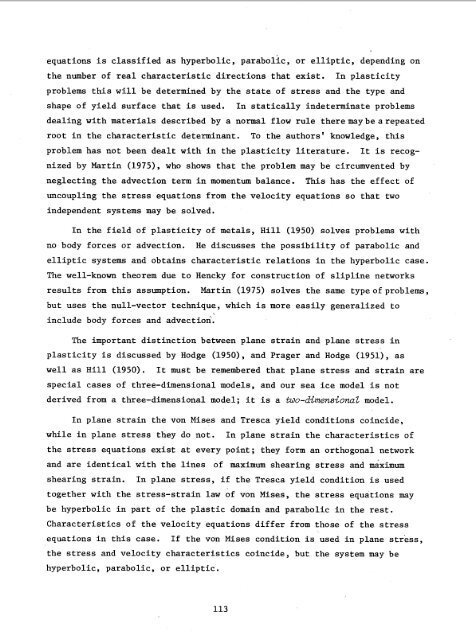AIDJEX Bulletin #40 - Polar Science Center - University of Washington
AIDJEX Bulletin #40 - Polar Science Center - University of Washington
AIDJEX Bulletin #40 - Polar Science Center - University of Washington
Create successful ePaper yourself
Turn your PDF publications into a flip-book with our unique Google optimized e-Paper software.
equations is classified as hyperbolic, parabolic, or elliptic, depending on<br />
the number <strong>of</strong> real characteristic directions that exist. In plasticity<br />
problems this will be determined by the state <strong>of</strong> stress and the type and<br />
shape <strong>of</strong> yield surface that is used. In statically indeterminate problems<br />
dealing with materials described by a normal flow rule theremaybearepeated<br />
root in the characteristic determinant. To the authors' knowledge, this<br />
problem has not been dealt with in the plasticity literature. It is recognized<br />
by Martin (1975), who shows that the problem may be circumvented by<br />
neglecting the advection term in momentum balance. This has the effect <strong>of</strong><br />
uncoupling the stress equations from the velocity equations so that two<br />
independent systems may be solved.<br />
In the field <strong>of</strong> plasticity <strong>of</strong> metals, Hill (1950) solves problems with<br />
no body forces or advection. He discu6ses the possibility <strong>of</strong> parabolic and<br />
elliptic systems and obtains characteristic relations in the hyperbolic case.<br />
The well-known theorem due to Hencky for construction <strong>of</strong> slipline networks<br />
results from this assumption. Martin (1975) solves the same type<strong>of</strong>problems,<br />
but uses the null-vector technique, which is more easily generalized to<br />
include body forces and advection.<br />
The important distinction between plane strain and plane stress in<br />
plasticity is discussed by Hodge (1950), and Prager and Hodge (1951), as<br />
well as Hill (1950). It must be remembered that plane stress and strain are<br />
special cases <strong>of</strong> three-dimensional models, and our sea ice model is not<br />
derived from a three-dimensional model; it is a two-dimensional model.<br />
In plane strain the von Mises and Tresca yield conditions coincide,<br />
while in plane stress they do not. In plane strain the characteristics <strong>of</strong><br />
the stress equations exist at every point; they form an orthogonal network<br />
and are identical with the lines <strong>of</strong> maximum shearing stress and maximum<br />
shearing strain. In plane stress, if the Tresca yield condition is used<br />
together with the stress-strain law <strong>of</strong> von Mises, the stress equations may<br />
be hyperbolic in part <strong>of</strong> the plastic domain and parabolic in the rest.<br />
Characteristics <strong>of</strong> the velocity equations differ from those <strong>of</strong> the stress<br />
equations in this case. If the von Mises condition is used in plane stress,<br />
the stress and velocity characteristics coincide, but the system may be<br />
hyperbolic, parabolic, or elliptic.<br />
113








